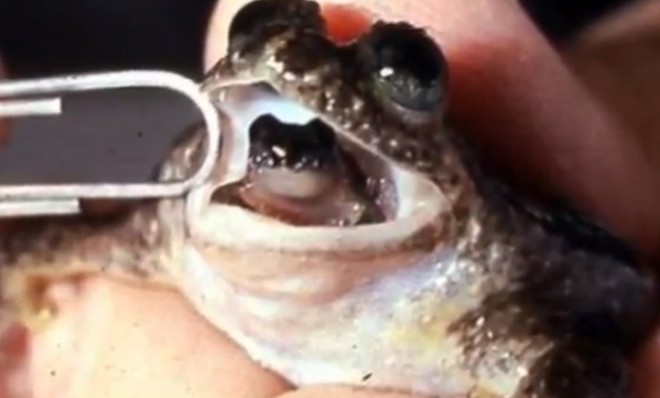This long-extinct frog is being brought back from the dead
Are the dodo and woolly mammoth next?

Once native to the wet and temperate climate of Queensland, Australia, the gastric-brooding frog (Rheobatrachus silus) is different from most other frogs. For starters, it gives birth from its mouth, swallowing eggs to hide in its stomach until they're ready to hatch. Secondly, all of the frogs have been dead since 1979, likely due to deforestation and pollution.
Now, scientists working on a de-extinction program called the Lazarus Project want to bring the baby-belching amphibian back to life. In a new experiment presented in front of the National Geographic Society, researchers successfully re-constructed the gastric-brooding frog's embryos by combining its DNA with the eggs of a related species, the Great Barred Frog (Mixophyes fasciolatus).
If the cloning technique sounds familiar, it is. It's really not all that dissimilar from the science fiction made famous in Jurassic Park. According to the Sydney Morning Herald, a team led by University of NSW palaeontologist Mike Archer "painstakingly inserted DNA extracted from a frozen specimen of the bizarre gastric-brooding frog" into "hundreds of donor eggs from a distant relative, the great barred frog, whose DNA had been deactivated by UV light." At first, the single-cell eggs "just sat there," Archer tells the Sydney Morning Herald. "But then, all of a sudden, one of the cells divided, and then it divided again, and again."
The Week
Escape your echo chamber. Get the facts behind the news, plus analysis from multiple perspectives.

Sign up for The Week's Free Newsletters
From our morning news briefing to a weekly Good News Newsletter, get the best of The Week delivered directly to your inbox.
From our morning news briefing to a weekly Good News Newsletter, get the best of The Week delivered directly to your inbox.
Unfortunately, the newly formed embryos only survived for three days. Nevertheless, researchers are optimistic about the possibility of soon bringing the extinct frogs back to life. "We're increasingly confident that the hurdles ahead are technological and not biological and that we will succeed," says Archer.
Using cloning to bring back long-dead species remains a thorny issue. In 2009, for example, Spanish researchers briefly brought back the Pyrenean ibex, a mountain goat that disappeared at the turn of the century. The clone died just minutes later due to a lung deformity. And many critics also point out that cloning endangered species is not an effective conservation strategy, since it fails to address the reasons the animals were endangered to begin with.
Although the relatively short shelf life of DNA means bringing the dinosaurs back through genetic engineering is likely a pipe dream, scientists from all over the globe are refining advanced cloning techniques to bring back other extinct species, including New Zealand's giant moa, the dodo, and perhaps even the woolly mammoth.
A free daily email with the biggest news stories of the day – and the best features from TheWeek.com
-
 10 concert tours to see this winter
10 concert tours to see this winterThe Week Recommends Keep cozy this winter with a series of concerts from big-name artists
-
 What are portable mortgages and how do they work?
What are portable mortgages and how do they work?the explainer Homeowners can transfer their old rates to a new property in the UK and Canada. The Trump administration is considering making it possible in the US.
-
 What’s the best way to use your year-end bonus?
What’s the best way to use your year-end bonus?the explainer Pay down debt, add it to an emergency fund or put it toward retirement